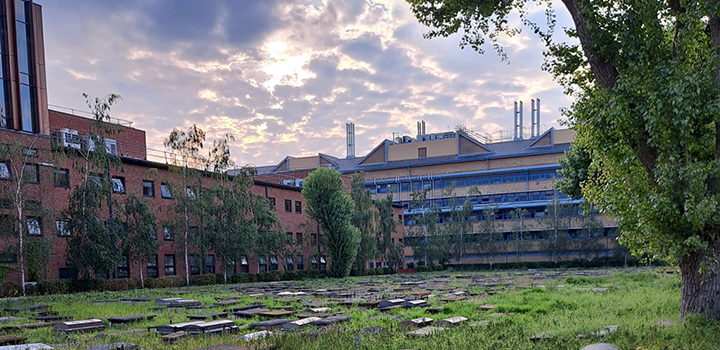UEA graduate visits literary sights in honour of W. G. Sebald
By: UEA Alumni team

UEA graduate Caroline Winter-Jones shares her alumni story of a recent journey in honour of W.G.Sebald.
The business manager who received us at the former Great Eastern Hotel was not ‘a Portuguese called Pereira’ with a big key but an Italian called Elena with a passcard.
She was, however, equally courteous when we wandered into the grandiose foyer of the five-star hotel that now goes by the name of Andaz and still forms the south flank of Liverpool Street Station.
It was May 18, 2024, which would have been WG Sebald’s 80th birthday, when we six UEA alumni, who were taught by Max (as we knew him) in the 1980s, gathered to mark this day with a walk through London’s East End on a route narrated by the titular character in his 2001 novel, Austerlitz.
We had started our journey at the hotel, where Jacques Austerlitz and the narrator meet, and which stands on the site of the original St Mary of Bethlehem priory and ‘hospital for the insane and other destitute persons which has gone down in history under the name of Bedlam’.
Clutching annotated copies of the book, our literary group had asked if we could view the Masonic temple that was ‘incorporated into the hotel by the directors of the railway company’ when the building was first erected in 1912.
We followed the gracious Elena up a broad staircase to the first floor, where she opened a heavy wooden portal leading to steps down into an ornate windowless room of dark mahogany, gilt motifs, and 12 types of marble.

Masonic temple
The Grecian temple hidden in the hotel’s depths was built ‘with the utmost luxury’ but had been forgotten for decades behind an interior wall until the hotel was redesigned by Terence Conran in the early 2000s.
Our next stop was in search of the ‘Ladies’ Waiting Room’ in Liverpool Street where Austerlitz first relives a memory of arriving alone as a four-year-old boy from Prague in 1939.
You can see the traces of the former hotel reception that is now WH Smith in the refurbished station, where we gazed up from the racks of sweet drinks, vaping materials and pre-packaged snacks at the chandeliers and ornate cornicing. The waiting room itself ‘vanished forever in the rebuilding’ and relentless development of the area, which is today once again threatened by plans for a towering glass office block.

Former hotel reception that is now WH Smith
We paused on the now light-filled concourse at a Kindertransport memorial that has frozen in bronze the forlorn faces of two displaced children. Für das Kind was placed here in 2003, two years after Sebald’s untimely death. We paused again at a second memorial erected outside in 2006. This one only seems to highlight the disjuncture between the murderous events of the Second World War and these perky, shiny figures representing the ten thousand young Jewish souls who were shipped via Harwich to London to escape Nazi persecution in Germany, Austria and Czechoslovakia.

Kindertransport memorial
From there we made our way to Alderney Road (Alderney Street in the book), where Austerlitz resided and the narrator sometimes stayed over. We peered through the letter box of the door in the wall that led to a tiny Ashkenazi cemetery. But no ‘small, almost dwarf-like woman of perhaps seventy years old’ in her slippers came out to let us in. We made do with a flirty local cat and chats with passing neighbours who said they had ‘never seen the door open’.
Walking along the Mile End Road, through Saturday market crowds, we passed the Queen Mary University campus, where a pro-Palestinian protest was under way. Security at the entrance was unusually tight but after explaining our purpose to an Albanian security guard, he was persuaded we had no activist intent. He led us to the 19th century Novo Jewish cemetery (pictured at the top of this article), with ‘its distinctive flat gravestones that represent the equality of all people in death’, which lies like an encampment of a very different kind in the midst of the university buildings. This was not a stop mentioned in Austerlitz but our own homage to urban walkers who have gone before including the poet Stephen Watts, who led Sebald on his ‘East End drifts’, the writer Iain Sinclair, who retraced Watts’s steps, and the film-maker John Rogers, who video-blogged the route.
At some waymarks, we stopped to read passages from the book, speaking aloud Sebald’s lines that invoke a palimpsest of the dead and the dispossessed, laid down by the loss, grief and destruction of humanity.
Our final destination was Tower Hamlets cemetery, by which time the May evening sun was breaking through. We meandered through the tumbling gravestones and broken-armed angels, trying to find one that matched a grainy picture in the book.
Of course, as these were Sebald’s words we were following, we may have been looking for something that was never there at all. He collected buried histories and miscellaneous photographs, facts and artefacts, and embedded them in his works to confound the fiction/non-fiction categorisers forever.
Caroline Winter-Jones
Quotes from W.G. Sebald Austerlitz, Queen Mary University of London (2014) 'Jewish cemetery at Mile End listed by English Heritage', and John Rogers, (2020), ‘Following WG Sebald’s Austerlitz through the East End’
For more on W.G. Sebald see our longform article on his time at UEA. Join us on 12 June to celebrate the recent publication of ‘Shadows of Reality: A Catalogue of W.G. Sebald’s Photographic Materials’.